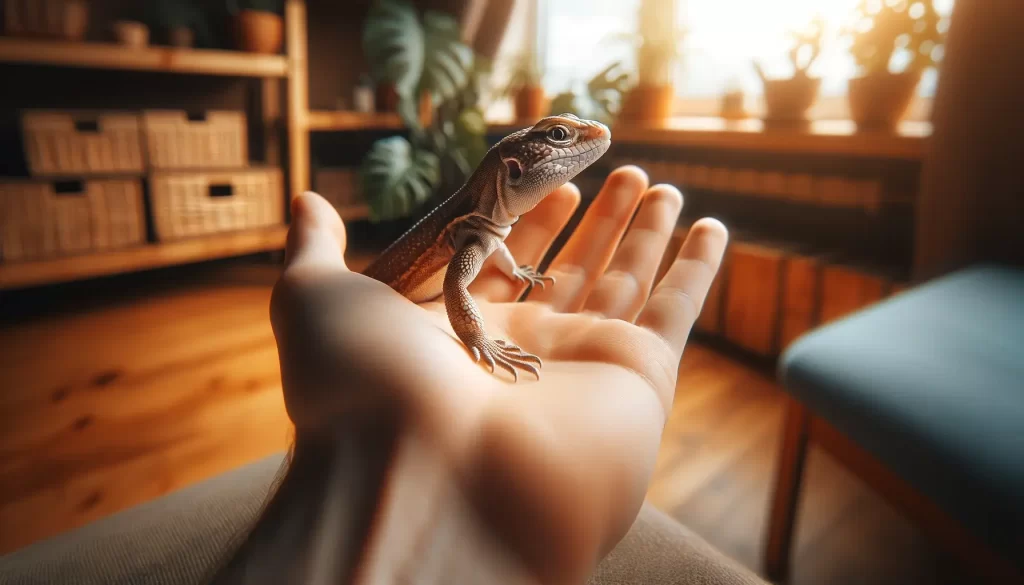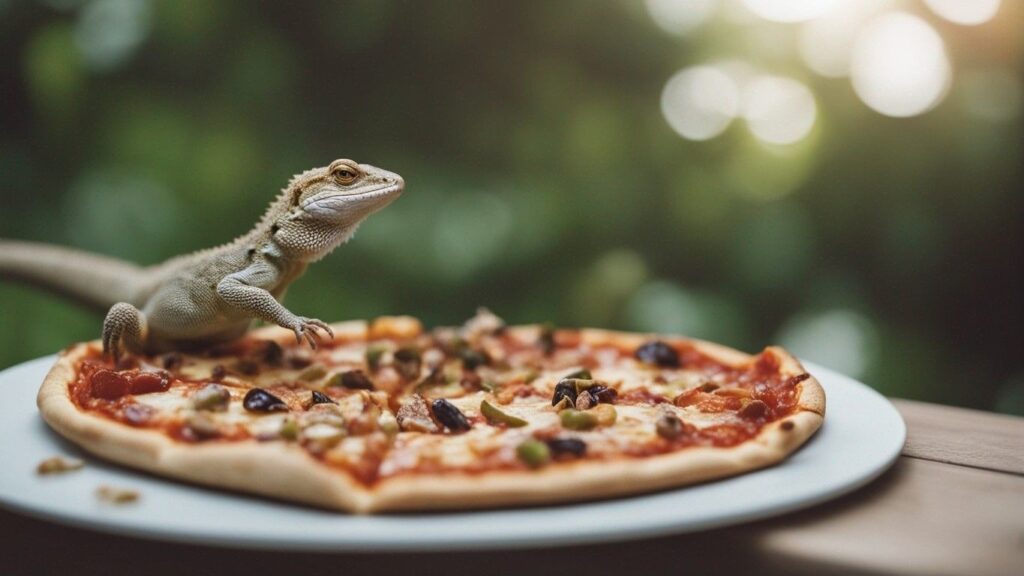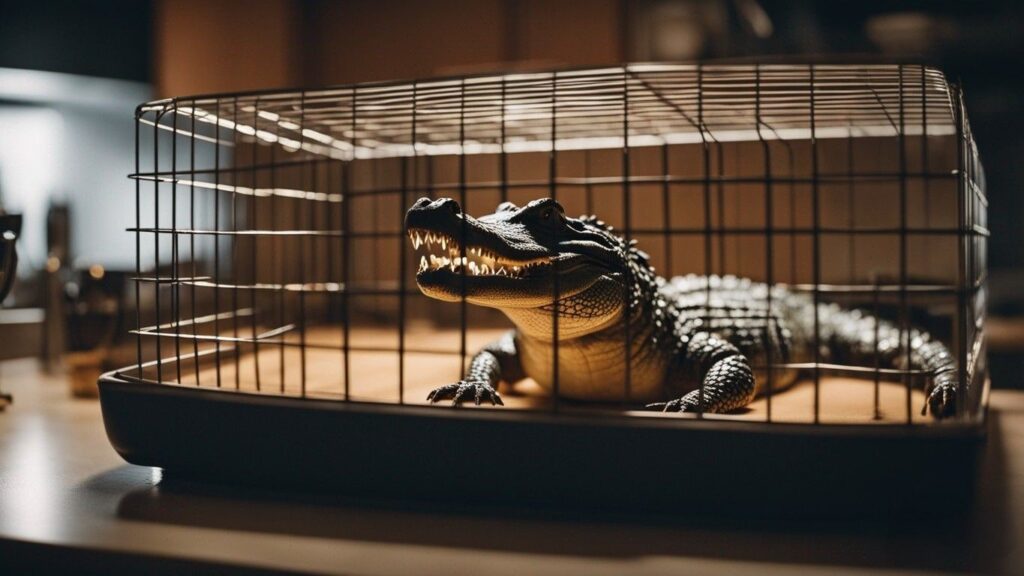
Have you ever wondered if your pet lizard has the capability to show affection? Many pet owners are curious about the emotional connection they can have with their scaly companions.
While it may seem surprising, pet lizards can indeed display signs of affection towards their owners.
From gentle head bobs to tail wagging, these seemingly cold-blooded creatures have the ability to form a bond with their human counterparts.
In this article, we will uncover the fascinating world of lizard emotions and explore how they express their affection in their own unique ways.
So, if you’re a proud owner of a pet lizard or simply curious about these remarkable reptiles, read on to discover the intriguing ways in which they express their love.
Body Language
When it comes to body language, pet lizards have various ways of expressing themselves. One of the most noticeable aspects is eye contact.
Lizards may not have expressive eyes like dogs or cats, but they can still convey a message through their gaze.
Maintaining eye contact with you is a sign of acknowledgement and interest. It shows that they are aware of your presence and are paying attention to you.
So, if you notice your lizard locking eyes with you, it’s a good indication that they are comfortable around you and may even be seeking some interaction or affection.
Another aspect of their body language is tail movement. Lizards use their tails for balance and communication.
Paying attention to the movements of their tail can provide insight into their mood and emotions.
A calm and relaxed lizard will typically have a still tail, while a tail that is twitching or waving rapidly may indicate agitation or fear.
However, it’s important to note that tail movement can vary among different species of lizards, so it’s essential to understand the specific behavior of your pet.
The body position of a lizard can also give you clues about their mood and comfort level. If your lizard is lying flat on the ground with its body fully extended, it usually means they are relaxed and content.
On the other hand, if they are raised up on their legs with their body elevated, it might be a sign of alertness or even aggression.
Understanding your lizard’s body language can help you establish a better connection with them and ensure their well-being.
Vocalization
While lizards are not known for being vocal creatures, some species do make sounds as a means of communication or defense.
Hissing is one of the most common vocalizations you may hear from a lizard. It is typically a warning sign that they feel threatened or agitated.
Hissing is often accompanied by a puffing up of their body and may be their way of trying to intimidate or ward off potential predators or perceived threats.
Chirping is another form of vocalization that some lizards, such as geckos, may exhibit. This sound is usually heard during mating or territorial displays.
It’s a way for them to attract a mate or establish their presence in their environment. Chirping sounds can vary between species and may range from soft and melodic to loud and sharp.
Clicking noises are also common among certain lizards, such as anoles. This sound is produced by rapidly opening and closing their mouth and is often used as a form of communication with other lizards.
Clicking can serve as a territorial warning or a means of attracting a mate. While it may not be a direct form of affection towards their owners, it is an interesting aspect of their vocalization repertoire.
Physical Contact
Physical contact with their owners is another way in which pet lizards may show affection or seek interaction.
One form of contact is climbing on you. If your lizard climbs on you willingly and comfortably, it can be a sign that they trust you and enjoy your company.
It may even indicate that they view you as a safe and warm resting spot.
Another form of physical contact is touching with their tongue. Lizards have a unique way of exploring their environment by using their tongues to gather information about objects or individuals.
If your lizard gently touches you with their tongue, it can be a sign of curiosity and a way for them to learn more about you. It’s their equivalent of a handshake, so to speak.
Headbutting is another behavior that some lizards may display as a form of physical contact. It might seem odd or even aggressive at first, but it’s actually a sign of affection.
Lizards, such as bearded dragons, may gently bump their heads against you to establish a bond and express trust. It’s their way of saying, “Hey, I’m here and I consider you a friend.”
Grooming Behavior
Grooming behavior is not restricted to furry animals; lizards also engage in this activity to keep themselves clean and maintain their overall health.
Licking is one common grooming behavior observed in lizards. They use their tongues to remove dirt or debris from their scales.
While they may not lick their owners like a dog or a cat would, witnessing them engage in self-grooming can be a sign that they feel comfortable and secure in their environment.
Nibbling is another grooming behavior that can be seen in some lizards. It’s their way of removing shedding skin or dead scales from their body.
Sometimes, lizards may gently nibble on their owners’ fingers or hands, especially if they have shedding skin.
While it may not be a direct display of affection, it does show that they perceive you as a safe and familiar presence in their environment.
Another aspect of grooming is assisting in shedding. Lizards shed their skin periodically as they grow, and this process can sometimes be challenging for them.
As an owner, you may notice your lizard rubbing against objects or rough surfaces to aid in the shedding process.
By providing a suitable environment with objects for them to rub against, such as branches or rocks, you can help facilitate their shedding and ensure their comfort.
Recognizing Their Owners
Lizards may not respond to their owners in the same way that dogs or cats do, but they can still recognize and acknowledge their presence.
One way they do this is by responding to your voice. While they may not understand the words you are saying, they can recognize the familiar sound of your voice.
If your lizard perks up, turns its head, or shows signs of alertness when you speak to them, it’s a positive indication that they recognize you and associate you with their primary caregiver.
Another way lizards recognize their owners is through the expectation of food. As their primary source of sustenance, you play a vital role in providing their meals.
When your lizard becomes accustomed to your feeding routine, they will start associating your presence with the arrival of food.
If they start showing excitement or anticipation when they see you approaching their habitat with their food, it’s a clear sign that they recognize you as their provider and have formed a connection with you.
Displaying comfort is another way lizards recognize their owners. If they are comfortable around you, they will exhibit relaxed body language, such as lying flat or basking under a heat source in your presence.
They may also show curiosity by observing you or their surroundings without signs of fear or stress.
When you see these behaviors, it shows that they trust you and have formed a bond based on positive experiences and interactions.
Feeding Interactions
Feeding time is a crucial aspect of a lizard’s day-to-day routine, and it often presents an opportunity for interaction and bonding between lizards and their owners. One common feeding interaction is feeding from the hand. Some lizards, such as certain species of geckos or bearded dragons, may readily accept food directly from their owner’s hand. This behavior shows a level of trust and comfort, as they are engaging in a direct interaction with you while satisfying their hunger.
Recognizing their feeder is also an important aspect of the feeding interaction. Lizards can differentiate between different individuals and may have preferences for specific people when it comes to feeding. If your lizard consistently shows excitement or approach behavior when they see you coming with their food, it indicates that they have formed a positive association with you as their feeder.
Demand for attention during feeding is another way in which lizards show affection or seek interaction. Some lizards may become more active or vocal when they want attention or are anticipating their meal. They may scratch at their habitat or even start headbutting their enclosure to get your attention. While it may seem like they are demanding food, it can also be interpreted as a desire for interaction and engagement with you, their caregiver.
Repetitive Behavior
Repetitive behaviors can be observed in lizards for various reasons, such as territorial marking, stress, or even boredom. However, some repetitive behaviors can also indicate a form of affection or attachment towards their owners. One such behavior is following you around. If your lizard consistently trails behind you or stays close to your presence while you move around, it can be a sign that they enjoy your company and prefer to be near you.
Scratching at glass is another repetitive behavior that lizards may exhibit when they want attention or are seeking interaction. Lizards may scratch at the glass of their enclosure to get your attention or to indicate that they want to be let out for exploration. While it may seem like an annoyance, it’s important to understand that it is their way of communicating and expressing their needs or desires.
Pawing at their cage can also be a repetitive behavior that lizards display to seek interaction or attention. They may use their front legs to push or scratch at the bars or substrate of their habitat to get your attention. By responding to their behaviors and providing positive interaction, you can reinforce their bond with you and ensure their mental stimulation and well-being.
Territorial Behavior
Territorial behavior is a natural instinct for many lizards, as they establish and defend their territory. While this behavior may not be directly related to showing affection towards their owners, it’s essential to understand and respect their boundaries. Lizards may display territorial behavior by puffing up their bodies, opening their mouth wide to display their teeth or gums, or even hissing as a warning.
Recognizing boundaries means understanding the signs of discomfort or aggression that your lizard may display when they feel their territory is being invaded. It’s important to give them space when they show these signs and avoid actions that may trigger their defensive behavior. Respecting their boundaries will not only ensure their well-being but also contribute to building a trusting and positive relationship with your pet lizard.
Temperature Preferences
Lizards are cold-blooded creatures, which means they rely on external heat sources to regulate their body temperature. As a result, they often seek warmth from their environment, including their owners. Seeking warmth from you can be seen as a form of affection, as they perceive your body heat as a source of comfort and security.
Basking near their owner is another way in which lizards show their preference for warmth and social proximity. By positioning themselves close to you while they bask under their heat lamp or under a warm spot, they are not only benefiting from the heat but also seeking your presence for companionship. It’s a mutually beneficial arrangement where both you and your lizard can enjoy each other’s company while fulfilling their temperature needs.
Socialization with Other Lizards
While lizards might not be known for their social nature like some mammalian pets, they can still exhibit social behaviors with their own kind. Displaying friendliness is one aspect of socialization that can be observed when lizards interact with each other. They may engage in gentle head bobbing, body movements, or even direct physical contact, such as licking or nuzzling. These behaviors demonstrate their ability to form social bonds and communicate within their species.
Sharing space is another behavior that indicates a level of socialization among lizards. Some species of lizards, such as certain types of geckos, may cohabitate peacefully in the same enclosure. While it’s essential to ensure that the enclosure meets the specific needs and requirements of each lizard, observing them sharing space without aggression or stress is a positive indication of their ability to coexist peacefully.
Competing for attention is a behavior that can be observed when multiple lizards are present in the same environment. Lizards may display territorial behavior, engage in displays of dominance, or even compete for resources, such as food or basking spots. While competition may not be directly linked to showing affection towards their owners, it does demonstrate their ability to interact and engage within a social context.
Final Thoughts
In conclusion, while pet lizards may not exhibit affection in the same way as traditional pets like dogs or cats, they can still display behaviors that indicate a bond and connection with their owners.
Understanding their body language, vocalizations, feeding interactions, grooming behavior, and recognizing their boundaries are crucial in building trust and fostering a positive relationship.
While every lizard is unique, taking the time to observe and interpret their behaviors will allow you to better understand their individual preferences and needs, ultimately strengthening the bond between you and your pet lizard.
So, despite their scaly exterior, don’t be fooled – your pet lizard can indeed show affection in its own unique way.



